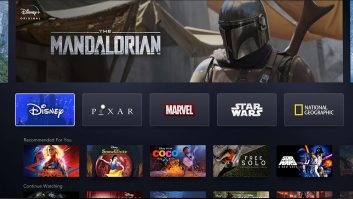The most remarkable element of the news that broke yesterday isn’t just that Disney Plus is exactly a year old, but that reaching 60-90 million subscribers was the company’s ambition for 2024. That it has done so within its first year is, as mentioned, remarkable; as of 3rd October, Disney Plus has registered 73.7 million subscribers.
Some commentators had been dubious as to whether the platform would reach past 13 million by the end of 2020 in their pre-launch estimates, but the first day alone saw 10 million people sign up to the service, in various forms. Those early forecasts could not, of course, have budgeted for a global pandemic, the effects of which have without question boosted subscriber numbers as consumers around the world were confined to their homes, and scheduled programming shuddered to a halt.
The platform’s Q1 and Q2 subscriber numbers of 26.5 million and 36.5 million had shot up to 57.5 million by its third quarter, and by August – when Disney last published its numbers – those figures had inflated again to 60.5 million. The release of yesterday’s figures shows a two-month growth surge of around 14 million subscribers (more than that predicted by Morgan Stanley pre-launch for the whole of 2020).
The question now would be whether the platform can sustain this level growth; or rather, for how long this trajectory can continue with the existing model before it has to add more content strings to its bow. Disney is certainly investing significantly in its streaming business, as CEO Bob Chapek US network CNBC last month as the company announced a major restructure: “We are titling the scale pretty dramatically [towards streaming]”.
As the network suggested, the next steps would appear to be how Disney retains these subscribers longer term, especially as we (hopefully) emerge from the depths of pandemic conditions at some point in 2021 and consumers spend less time at home (possibly having already gorged through Disney Plus’ content offering). If it does indeed want to follow in the slipstream of Netflix, you feel it will need more baby Yodas and original content pouring into what is currently, by comparison, a more limited offering if it wants to both grow and retain its subscriber base.
Media analyst Paolo Pescatore believes that short term growth is still attainable because Disney Plus is not yet as globally pervasive as Netflix (for example), and therefore launches into new markets and partnerships with regional telcos can help to maintain subscriber growth. He also agrees that Disney will need “a steady stream of big blockbuster shows to drive subscribers and maintain usage”.
He told TVBEurope, “Thanks to Disney Plus, the company has seen phenomenal growth within a short period of time. With launches into new markets including Latin America, new blockbuster hits and partnerships with local telcos, expect subs growth to proliferate,” he said.
“Disney is fast becoming like Netflix with all eyes on video streaming subs and a growing content slate. Streaming is one of the few areas and requires a significant long term investment strategy. However, for now it is apparent that streaming will not make up the shortfall in revenue/profit losses from other businesses like parks and studios.”






